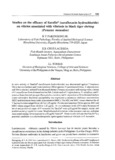Identification of a chromosomally-encoded sucrose operon-like gene cluster in Vibrio parahaemolyticus strain PH05 isolated from Negros Island, Philippines

Associated URL
www.biorxiv.orgDate
2021-02-27Page views
280Metadata
Show full item recordCited times in Scopus
Share
Abstract
The ability of bacteria to metabolize a wide variety of carbon sources has been known to aid in their ability for efficient colonization. Vibrio parahaemolyticus, a known aquatic pathogen has been reported to have the ability to metabolize a number of carbohydrates including D-glucose, D-galactose, L-arabinose, D-mannose, and D-ribose to name a few. Classical isolation of V. parahaemolyticus from other members of the family Vibrionaceae relies on its carbon utilization pattern. Conventionally, V. parahaemolyticus lacks the ability to utilize sucrose and this has been the basis for its isolation using the Thiosulfate-citrate-bile salts-sucrose (TCBS) agar. Reports of V. parahaemolyticus having the ability to utilize sucrose have been presented yet there is paucity of information and detailed study on this phenotype. In this study, we report the V. parahaemolyticus strain PH05 that has the ability to metabolize sucrose. Phenotypic and genotypic characterization of this V. parahaemolyticus strain isolated from Negros Island, Philippines, revealed that V. parahaemolyticus strain PH05 is atypical appearing yellow on TCBS agar plates. It is capable of utilizing sucrose, unlike the majority of V. parahaemolyticus isolates. Genome analyses of this strain revealed the presence of a chromosomally encoded sucrose operon-like gene cluster encoded in chromosome 2 with the following sucrose-utilization associated genes: scrY, ccpA, treP, scrK, and scrB genes coding for sucrose porin, catabolite control protein A, PTS System sucrose-specific EIIBC component, fructokinase, and sucrose-6-phosphate hydrolase. The mode of transmission of these genes to V. parahaemolyticus strain PH05 is still unknown. However, the presence of insertion sequences (IS) and phage elements in the same chromosome suggests horizontal gene transfer events. Taken together, our results point to the possibility that acquired sucrose utilization genes may contribute to the fitness of V. parahaemolyticus strain PH05 in the environment.
Suggested Citation
De Mesa, C. A. E., Mendoza, R. M., Amar, E. C., de la Peña, L. D., & Saloma, C. P. (2021). Identification of a chromosomally-encoded sucrose operon-like gene cluster in Vibrio parahaemolyticus strain PH05 isolated from Negros Island, Philippines [Preprint]. bioRxiv. https://doi.org/10.1101/2021.02.27.433172
Subject
Taxonomic term
Collections
- AQD Journal Articles [1248]
Related items
Showing items related by title, author, creator and subject.
-
Emergency response to emerging diseases: TiLV in tilapia
Senapin, Saengchan (Aquaculture Department, Southeast Asian Fisheries Development Center, 2019)Tilapia lake virus (TiLV) is a novel RNA virus resembling Orthomyxovirus. It has been recently re-classified to Tilapia tilapinevirus species, under Tilapinevirus genus, Amnoonviridae family (ICTV, 2018). Since the first ... -
Studies on the efficacy of Sarafin® (sarafloxacin hydrochloride) on vibrios associated with vibriosis in black tiger shrimp (Penaeus monodon)
Pakingking, Rolando V., Jr.; Lacierda, Erlinda; Torres, James L. (Fish Health Section, Asian Fisheries Society, 2002)In vitro activity of Sarafin® (sarafloxacin hydrochloride) was determined against 7 luminous Vibrio harveyi isolates and 3 non-luminous Vibrio species (V. parahaemolyticus, V. alginolyticus and Vibrio species) isolated ... -
Important diseases and practical control measures in shrimp culture in Japan
Yuasa, Kei; Mekata, Toru; Sato, Jun (Aquaculture Department, Southeast Asian Fisheries Development Center, 2016)The gross product from sea culture in Japan was about USD 3.4 billion in 2013 with kuruma shrimp Marsupenaeus japonicus constituting 2% of the total production. In recent years, annual shrimp production has reached about ...



